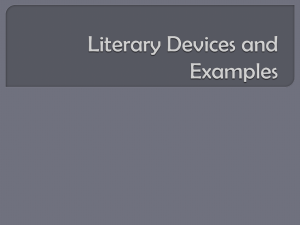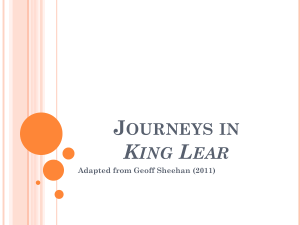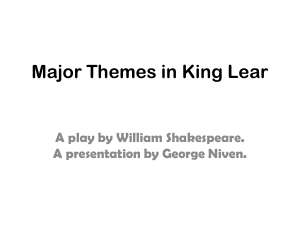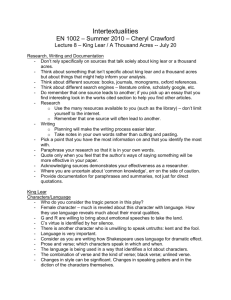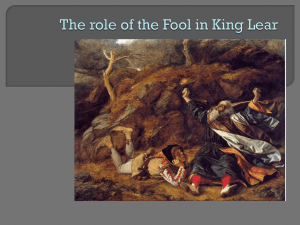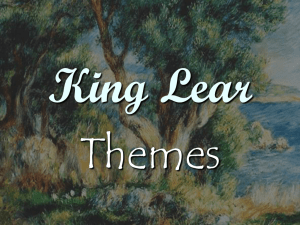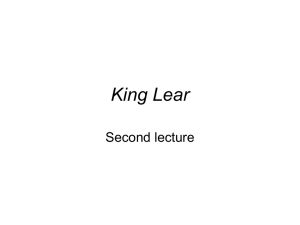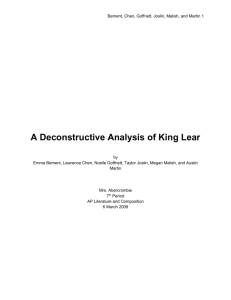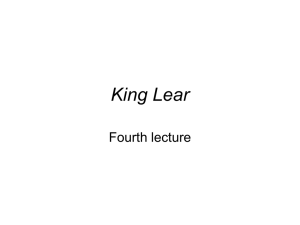King Lear
advertisement
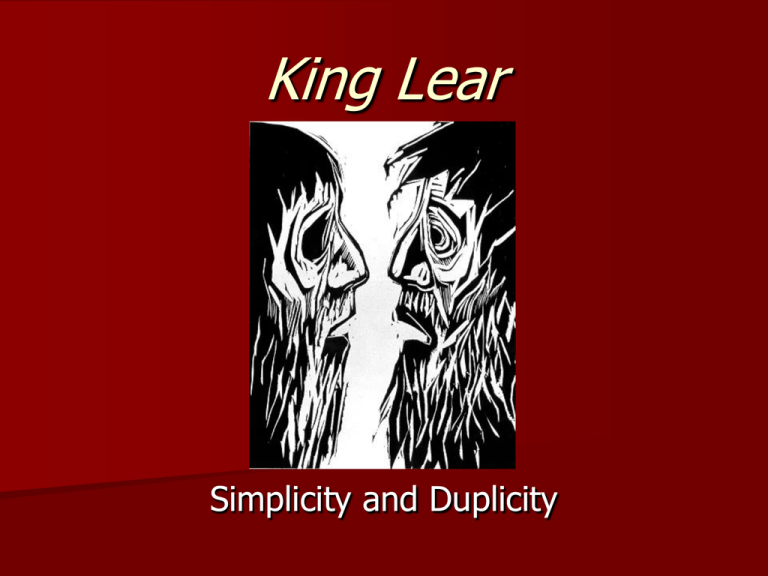
King Lear Simplicity and Duplicity Dating the Play Shakespeare wrote King Lear in late 1605 or 1606 (RSC) The first performance was for King James VI/I at Whitehall on December 16, 1606. Burbage and Armin were the main actors of Shakespeare’s company, The King’s Men, at that time. Most likely, Richard Burbage (c. 15671619) played Lear and Robert Armin (15681615) played the Fool. Sources of the Legend of King Leir British and Irish mythology refers to a king called Ler, Leir or Lyr. A tale in which a daughter tells her father Leir she loves him as much as salt (and demonstrates that this means he is essential to her) first appears about 1136 in Geoffrey of Monmouth’s Historia Regum Britanniae. According to Monmouth, Lear ruled for 60 years. Raphael Holinshed retold Monmouth’s story of Lear in his Chronicles of England, Scotland, Ireland (1577). According to Holinshed, Lear ruled Britain for 40 years around 800 BC. Edmund Spenser included the story of Lear in Volume II of The Faerie Queene, published in 1590 (RSC). The Court of King Lear King Lear Goneril Regan Cordelia married to married to marries Duke of Cornwall King of France Duke of Albany Duke of Gloucester Edgar Earl of Kent Edmund The Fool In theory, there are but two classes of people: Nobles and Commoners. In practice, there are a huge number or gradations of both classes. These gradations are thought of as parts of a Great Chain of Being, which extends from God down to the lowest forms of life, and even to the trees and stones of the earth. The Great Chain of Being This Great Chain, first described by St. Thomas Aquinas, is what holds the world together. The Great Chain is as follows: The Great Chain of Being "This metaphor (of ‘the vast chain of being') served to express the unimaginable plenitude of God's creation, its unfaltering order, and its ultimate unity. The chain stretched from the foot of God's throne to the meanest of inanimate objects. Every speck of creation was a link in the chain, and every link except those at the two extremities was simultaneously bigger and smaller than another: there could be no gap.... “ God Angels Kings/Queens Archbishops Dukes/Duchesses Bishops Marquises/Marchionesses Earls/Countesses Viscounts/Viscountesses Barons/Baronesses Abbots/Deacons Knights/Local Officials Ladies-in-Waiting Priests/Monks Squires Pages Messengers Merchants/Shopkeepers Tradesmen Yeomen Farmers Soldiers/Town Watch Household Servants Tenant Farmers Shephards/Herders Beggars Actors Thieves/Pirates Gypsies Animals Birds Worms Plants Rocks (Tillyard) Lear and Fool Lear’s Fool The nameless Fool of King Lear is a natural, a simpleton inspired with the intuitive wisdom of nature. His stock joke is to engage another character in dialogue and demonstrate the folly of the other. He tries to help Lear recognize his folly with his raillery and common sense. The fool’s relationship with Lear, touchingly personal at times, vanishes with Lear’s sanity in the storm. The fool’s disappearance may indicate his sanity, or at least his survival instinct. Parallel Plots The Shakespearean practice of complementing the main plot with a subplot reaches its fullest development in King Lear. The source of the overplot is a Celtic tale about a father with kind and unkind daughters. The underplot, about a father with kind and unkind sons, is drawn from Sidney’s Arcadia (Levin). Lear and Gloucester The juxtaposition of these two characters develops the following themes: Authority Folly Eyes, sight and insight Loyalty and ingratitude Parents and children Inheritance Justice Nothing Edgar, Lear and Gloucester Edgar and Edmund The contrast between Gloucester’s two sons illustrates these themes: Inheritance Identity Nature and nurture Parents and children Fortune Loyalty and ingratitude Love, self-love and false love Justice Regan, Goneril and Cordelia The differences and similarities among Lear’s three daughters develop additional themes: Authority Loyalty Crowns Division Civil disorder Politics Hospitality Warmth and cold Parents and children Corruption of servants Inheritance Ingratitude Love: Self-love, false love Age and youth Sin Truth Guilt Folly Why teach King Lear? many critics, King Lear is the greatest of all tragedies (Kermode 1297) The trial scene and Gloucester’s attempted suicide seem modern to playgoers used to Theatre of the Absurd. The themes touch the essence of what it is to be human, here and now as well as in Elizabethan England. To Themes in King Lear range from youth to age, wealth to poverty, authority to vulnerability, sanity to madness, cruelty to kindness, loyalty to ingratitude, everything to nothing. Authority Crowns Legitimacy Division Civil disorder Justice Fortune Politics Religion Loyalty Hospitality Warmth and cold The poor and poverty The elements Parents and children Corruption of servants Inheritance Ingratitude Nature and nurture Identity Love: Self-love and false love Age and youth Eyes, sight and insight Madness and sanity Sin Truth Guilt Nothing The worst “First there is mere existence, the inanimate class: the elements, liquids, and metals. But in spite of this common lack of life there is a vast difference of virtue; water is nobler than earth, the ruby than the topaz, gold than brass…. Next there is existence and life, the vegetative class, where again the oak is nobler than the bramble. Next there is existence, life and feeling, the sensitive class. In it there are three grades….The three classes lead up to man, who has not only existence, life and feeling, but understanding: he sums up in himself the total faculties of earthly phenomena.… But as there had been an inanimate class, so to balance it there must be a purely rational or spiritual. These are the angels, linked to man by community of the understanding, but freed from simultaneous attachment to the lower faculties…. Now, although the creatures are assigned their precise place in the chain of being, there is at the same time the possibility of change. The chain is also a ladder.…There is a progression in the way the elements nourish plants, the fruits of plants beasts, and the flesh of beasts men. And this is all one with the tendency of man upwards toward God“ (Tillyard, 23, 25-6). Works Cited Kermode, Frank, ed. King Lear. The Riverside Shakespeare. Ed. Herschel Baker and others. 2nd ed. 1297-1302. Levin, Harry. “General Introduction.” The Riverside Shakespeare. Ed. Herschel Baker and others. 2nd ed. 125. Royal Shakespeare Society. “King Lear: Shakespeare’s Sources.” http://www.rsc.org.uk/lear/about/sources.html “The Great Chain of Being.” http://jackytappet.tripod.com/chain.html Tillyard, E.M.W. The Elizabethan World Picture. London: Chatto, 1960.
